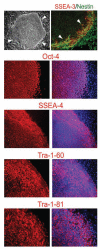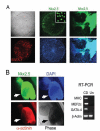Patents on Technologies of Human Tissue and Organ Regeneration from Pluripotent Human Embryonic Stem Cells
- PMID: 23355961
- PMCID: PMC3554241
- DOI: 10.2174/2210296511101020142
Patents on Technologies of Human Tissue and Organ Regeneration from Pluripotent Human Embryonic Stem Cells
Abstract
Human embryonic stem cells (hESCs) are genetically stable with unlimited expansion ability and unrestricted plasticity, proffering a pluripotent reservoir for in vitro derivation of a large supply of disease-targeted human somatic cells that are restricted to the lineage in need of repair. There is a large healthcare need to develop hESC-based therapeutic solutions to provide optimal regeneration and reconstruction treatment options for the damaged or lost tissue or organ that have been lacking. In spite of controversy surrounding the ownership of hESCs, the number of patent applications related to hESCs is growing rapidly. This review gives an overview of different patent applications on technologies of derivation, maintenance, differentiation, and manipulation of hESCs for therapies. Many of the published patent applications have been based on previously established methods in the animal systems and multi-lineage inclination of pluripotent cells through spontaneous germ-layer differentiation. Innovative human stem cell technologies that are safe and effective for human tissue and organ regeneration in the clinical setting remain to be developed. Our overall view on the current patent situation of hESC technologies suggests a trend towards hESC patent filings on novel therapeutic strategies of direct control and modulation of hESC pluripotent fate, particularly in a 3-dimensional context, when deriving clinically-relevant lineages for regenerative therapies.
Figures






Similar articles
-
Efficient derivation of human neuronal progenitors and neurons from pluripotent human embryonic stem cells with small molecule induction.J Vis Exp. 2011 Oct 28;(56):e3273. doi: 10.3791/3273. J Vis Exp. 2011. PMID: 22064669 Free PMC article.
-
Constraining the Pluripotent Fate of Human Embryonic Stem Cells for Tissue Engineering and Cell Therapy - The Turning Point of Cell-Based Regenerative Medicine.Br Biotechnol J. 2013 Oct 1;3(4):424-457. doi: 10.9734/BBJ/2013/4309#sthash.6D8Rulbv.dpuf. Br Biotechnol J. 2013. PMID: 24926434 Free PMC article.
-
Efficient derivation of human cardiac precursors and cardiomyocytes from pluripotent human embryonic stem cells with small molecule induction.J Vis Exp. 2011 Nov 3;(57):e3274. doi: 10.3791/3274. J Vis Exp. 2011. PMID: 22083019 Free PMC article.
-
Important precautions when deriving patient-specific neural elements from pluripotent cells.Cytotherapy. 2009;11(7):815-24. doi: 10.3109/14653240903180092. Cytotherapy. 2009. PMID: 19903095 Free PMC article. Review.
-
Human embryonic stem cells: derivation, maintenance and cryopreservation.Int J Stem Cells. 2011 Jun;4(1):9-17. doi: 10.15283/ijsc.2011.4.1.9. Int J Stem Cells. 2011. PMID: 24298329 Free PMC article. Review.
Cited by
-
Human Stem Cell Derivatives Retain More Open Epigenomic Landscape When Derived from Pluripotent Cells than from Tissues.J Regen Med. 2013 Jan 25;1(2):1000103. doi: 10.4172/2325-9620.1000103. J Regen Med. 2013. PMID: 23936871 Free PMC article.
-
Efficient derivation of human neuronal progenitors and neurons from pluripotent human embryonic stem cells with small molecule induction.J Vis Exp. 2011 Oct 28;(56):e3273. doi: 10.3791/3273. J Vis Exp. 2011. PMID: 22064669 Free PMC article.
-
Constraining the Pluripotent Fate of Human Embryonic Stem Cells for Tissue Engineering and Cell Therapy - The Turning Point of Cell-Based Regenerative Medicine.Br Biotechnol J. 2013 Oct 1;3(4):424-457. doi: 10.9734/BBJ/2013/4309#sthash.6D8Rulbv.dpuf. Br Biotechnol J. 2013. PMID: 24926434 Free PMC article.
-
MicroRNA Profiling Reveals Distinct Mechanisms Governing Cardiac and Neural Lineage-Specification of Pluripotent Human Embryonic Stem Cells.J Stem Cell Res Ther. 2012 Jul 13;2(3):124. doi: 10.4172/2157-7633.1000124. J Stem Cell Res Ther. 2012. PMID: 23355957 Free PMC article.
-
Efficient derivation of human cardiac precursors and cardiomyocytes from pluripotent human embryonic stem cells with small molecule induction.J Vis Exp. 2011 Nov 3;(57):e3274. doi: 10.3791/3274. J Vis Exp. 2011. PMID: 22083019 Free PMC article.
References
-
- Thomson JA, Itskovitz-Eldor J, Shapiro SS, Waknitz MA, Swiergiel JJ, Marshall VS, et al. Embryonic stem cell lines derived from human blastocysts. Science. 1998;282:1145–7. - PubMed
-
- Kirby T. Robert Edwards: Nobel Prize for father of in-vitro fertilization. Lancet. 2010;376:1293–0. - PubMed
-
- Martino G, Pluchino S. The therapeutic potential of neural stem cells. Nat Rev. 2006;7:395–406. - PubMed
Grants and funding
LinkOut - more resources
Full Text Sources
Other Literature Sources
